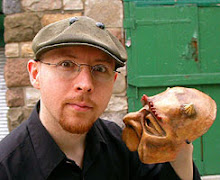
Articles about the mold making and casting processes coming soon.
Got the two puppets to finish first...
Molds are made of hot glue.
Very stable, and no small detail can be broken off...
The paper mache strips create a hard shell that is lightweight and extremely strong. They will bounce back instead of breaking. The finished puppets are often mistaken for carved wood.
UPDATE: the finished puppets from these molds and casting methods can be seen in my online portfolio:
www.creaturiste.blogspot.com








4 comments:
This is very nice, I have a few questions:
- How do you create the original positive before the casting? Clay? Do you go crazy on details on the original, or do you make corrections on the mold itself?
- Hot glue is definitely better than plaster for the mold?
- I'm not sure I understand how you get rid of the toilet paper on your casting. I've been using plaster molds, with no release, and it seems to work ok.
- And last, if you have any suggestions on sanding or other finishing techniques, I'd be very happy to hear them. My castings tend to have a lot of imperfections in them, it is very hard for me to get a smooth surface, even starting from a smooth mold. Worse: some imperfections seem to appear when I'm applying the gesso and/or paint, AFTER sanding.
Hi,
My originals are made of plastalina (oil-based clay). It does not dry, does nto crack, and will not cause dry hands or toxic silica dusts in the studio. My favorite brand is Chavant NSP.
Hot glue is not better than plaster at all, it's just that I needed to stop the problem of small details breaking off when pulling the paper casts from the mold. I was supposed to use silicone, but my home is not ventilated enough for this kind of work. Waiting for the summertime!
The toilet paper remains part of the final cast. I paste the edges down with diluted glue.
My first two layers of paper are applied very carefully,in very small pieces, so the finish is rather smooth to start with.
When I assemble my cast parts, I'm also careful. A layer of weaker, thinner paper can be applied as a smoothing step. I like brown paper towel for this. Sanding also helps.
I often use a cream I call Monster Bone. I wrote an article about it in this same blog. It,s as good for smoothing as it is for texturing.
I do not recommend acrylic gesso over paper mache if it was made with PVA based glues (white glues).
It appaears to add flex at first, but just makes the cast weak and brittle in a very short time.
Before painting with acrylics or the Monster Bone, I seal all my projects with two coats of diluted Weldbond. Weodbond is just the best at this. Acrylic paint loves to bond to it and never cracks.
Bonus: Acrylics painted directly over a white glue finish can often crack, which is a great effect, but only if you want it and know how to control it. It's better and less expensive than crackling mediums.
Do you have any plans for a tutorial? I would love to see a video podcast of your mold-making technique. I am looking to make my doll heads more detailed. Thanks for sharing.
Hi Juanita,
I'm planning to do an article about it, when I take the missing pics, next time I use the molds.
And I'll add a section about how I made the hot glue mold, next time I make one. I can't be more precise than that with dates, however.
As for a podcast, I'm running too much against time these days,so I can't even consider the possibility for now.
However, I can make it happen as a private online workshop, either live or with short video files.
Let me know if you are interested. My fees are quite reasonable.
Post a Comment